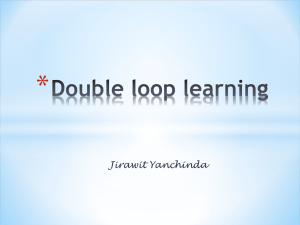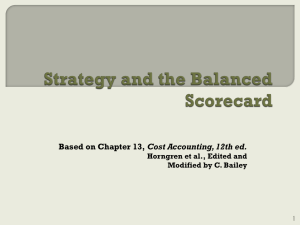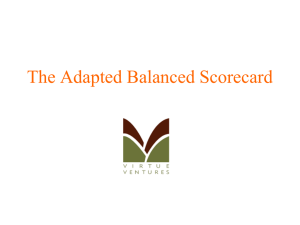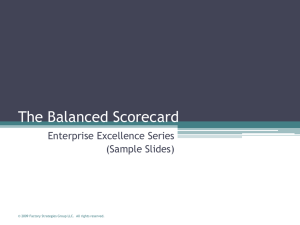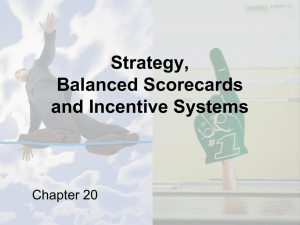Prezentacja programu PowerPoint
advertisement
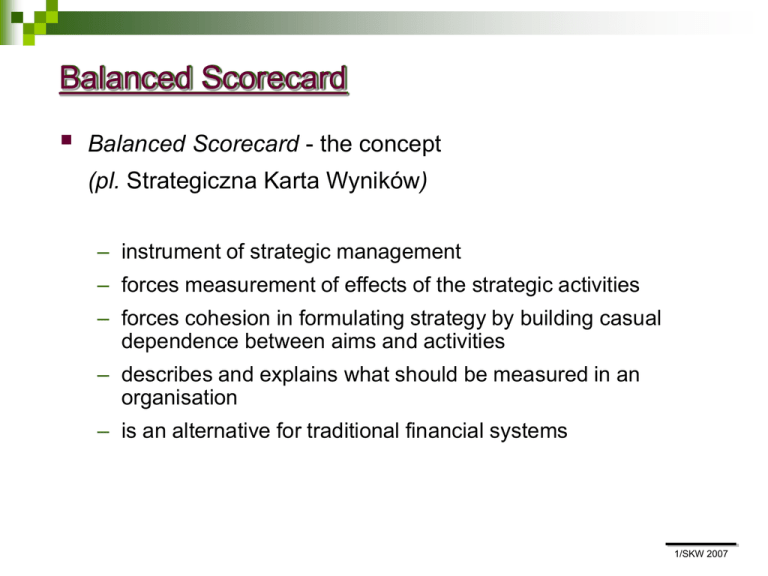
Balanced Scorecard Balanced Scorecard - the concept (pl. Strategiczna Karta Wyników) – instrument of strategic management – forces measurement of effects of the strategic activities – forces cohesion in formulating strategy by building casual dependence between aims and activities – describes and explains what should be measured in an organisation – is an alternative for traditional financial systems 1/SKW 2007 Reasons for origination of BSC Limitations in using financial measures – do not provide full information about elements crucial for competitive advantage – do not encourage managers to think short-term – allow for manipulation in decision-taking – show results of activities taken in the past – do not show the complete picture of the company's development – traditional measures originate from Cost Accounting; do not show where did costs come from – employees do not see the link between their work and measurement systems 2/SKW 2007 Circumstances under which BSC originated Research projects – 1987 – Corporate Scorecard developed by Analog Devices Inc. – 1988 – KPMG built for Apple Computer a performance measuring system – 1990 – project entitled „Measuring effectiveness in organisations in the future” have begun – project group: David Norton (Nolan Norton Institute) – project leader prof. Robert Kaplan (Harvard Business School) – advisor team of corporate directors from: Advanced Micro Devices, American Standard, Apple Computer, Bell South, Hewlett Packard, Shell Kanada, Cigna, DuPont, General Electric – results were decribed in: Robert S. Kaplan, David P. Norton, The Balanced Scorecard: Translating Strategy into Action, 1996 3/SKW 2007 Remark (1) Balanced Scorecard of a certain friend – as an impulse to reflect on how we realise our plans... /based on: My Balanced Scorecard, H.R. Friedag, W. Schmidt/ Vision: „Happy and satisfied” Strategy: „More time for people with whom I share my life and less stress" Reasons for which activities are undertaken: – family – friends – work – health 4/SKW 2007 Remark (2) Reasons How to realise Plan Performance Family Telephones to a wife 5 3,7 Flowers for a wife 4 3 Dinners and suppers together 4 5 Family trips 3 2 Dance/theater 2 2,5 Roller skates 1 1 Volunteer work at wind surfuring club 2 1 Get-togethers with friends 2 2 Trainings of co-workers 2 1,5 Team meeting 4 3 Work communication days 2 1 Work until 6:30 p.m. 2 1,5 Weekend without a company 2 1 Jogging 2 1,5 Work-out / Aerobic 4 2 Friends Work Health 5/SKW 2007 Remark (3) telephones to wife work-out / aerobic 5 flowers for a wife 4 jogging dinners and suppers together 3 2 weekend without a company family trips 1 0 work until 6:30 p.m. dance/theater work communication days is aim rollerskates meetings volunteer work at wind surfuring club education get-togethers with friends 6/SKW 2007 Four perspectives of BSC „Many leaders have their own visions which never become a common vision joining the whole organisation." That which is lacking is a theory which allows us to transform an individual vision into a joint vision” /P. Senge/ Balanced scorecard transforms the mission and strategy into aims and measures grouped according to four different perspectives: 1. Financial perspective 2. Customer perspective 3. Internal processes perspective 4. Development perspective 7/SKW 2007 Balanced scorecard - the model Financial perspective „How should stockholders see us, so that we are thought of as financially successful?” Customer perspective „How should customers see us, so that our vision is realised?” Vision and Strategy Internal processes perspective „What internal processes must we improve so that owners and clients of the firm are satisfied?” Development perspective „How can we maintain our ability to change and improve effectiveness in order to realise our vision?” 8/SKW 2007 Casual relation (1) If we increase the amount and quantity of training then... …. employees will possess a greater knowledge about our product offer If the employees will possess a greater knowledge about our products then... …. they will increase their selling effectiveness If the sales effectiveness increases then... …1) sales will increase and 2) operational costs will decrease If sales will increase and operational costs will decrease then... …profitability will increase 9/SKW 2007 Casual chain ROCE Financial perspective Customer perspective Customer loyalty Timely delivery Internal processes perspective Development perspective Process quality Process duration Employees' skills, abilities, competences 10/SKW 2007 Gist of the Balanced Scorecard Measurement system built based on financial and nonfinancial measures Measurement system built based on enterprise strategy Balanced system of: – Results with Leading measures (Lagg Indicators vs. Lead Indicators) – Objective with Subjective measures – Financial with Non-Financial measures – Short-term with Long-term measures – External with Internal measures 11/SKW 2007 Casual relation (2) Vision, mission, strategy Financial perspective „How should stockholders see us, so that we are thought of as financially successful?” Customer perspective „How should customers see us, so that our vision is realised?” Internal processes perspective „What internal processes must we improve so that owners and clients of the firm are satisfied?” Development perspectiv „How can we maintain our ability to change and improve effectiveness in order to realise our vision?” 12/SKW 2007 Financial perspective Aim from financial perspective: – main aim: to ensure stockholders a rate of return from an investment exceeding their expectations derived from an alternative involvement of capital bearing a similar level of risk Financial perspective measures whether the company's strategy realises its main aim Measures (based on financial reports) – return on investment - ROI – economic value added – EVA Financial strategies: – to reach a required growth and structure of revenues – to reduce costs and increase profitability – to increase utilisation of resources and effectiveness of investments 13/SKW 2007 Example: problems with financial measures 14/SKW 2007 Calculation of ROI Cost of products sold and services rendered Sales Sales, administrative and managerial costs Operational costs Income from operations Return on sales Other operational revenues – other operational costs Sales ROI Cash and cash equivalent Liabilities Short-term assets Return on assets Operational assets Inventory and other shortterm assets Long-term assets Legal assets Long-term assets Other long-term assets 15/SKW 2007 How to calculate ROI? ROI = = Income from operations Assets of operational unit Income from operations Sales = Return on sales x x Sales Assets of operational unit Return on assets 16/SKW 2007 Limitations of utilising ROI Using ROI to assess the activities has its limitations: – ROI measure is not directly tied to the goal of maximising the value of the enterprise for its owners – ROI used as an assessment measure of managers can lead to incorrect investment decisions – ROI is a short-term assessment measure 17/SKW 2007 Economic value added - EVA® EVA® (ang. economic value added) – measure that shows the value that the activities of a given investment center "add" to the value of an enterprise – shows the aim of the activities of an enterprise – maximialisation of its value EVA® = Wynik operacyjny – koszt kapitału x zainwestowane środki Limitations of applying the EVA®: – short-term measure based on annual data – its use can lead to faulty investment decisions taken by managers interested in short-term benefits Modifications of EVA®: – e.g. bonus bank – managers lose motivation to conduct long-term nonincome generating projects 18/SKW 2007 EVA® „Economic value added is based on a notion which we knew for a long time: that what we call profit, money, which are left to service own capital is not commonly a profit. Until an enterprise earns an amount greater than its cost of capital, until then it has a loss. It is unimportant that it pays taxes as it would experience a real profit. An enterprise still gives the economy less than it gets from it in terms of resources. (...) It does not create wealth, but it destroys it.” Peter Drucker 19/SKW 2007 EVA® in decision-taking (1) P/L Statement of Gamma Co. Sales revenue 2001 2002 12 200 000 20 000 000 Cost of goods sold (COGS) 7 400 000 15 000 000 Gross income from sales 4 800 000 5 000 000 Sales costs 1 200 000 1 000 000 Administrative costs 2 000 000 1 500 000 Income from sales 1 600 000 2 500 000 Other operational income 400 000 400 000 Other operational costs 500 000 400 000 Income from operations 1 500 000 2 500 000 Assets in 2001 - 10 000 000 zł, in 2002 – 20 000 000 zł Liabilities in 2001 - 3 000 000 zł, in 2002 – 4 000 000 zł Cost of capital set at 10% 20/SKW 2007 EVA® in decision-taking (2) 2001 2002 Return on sales 12,29% 12,5% Return on assets 1,22 1 ROI 15% 12,5% 800 000 900 000 1,5 mln-7mln*10%=0,8 mln 2,5mln-16mln*10%=0,9 mln EVA ® Calculation Decrease in ROI: worsening of the effectiveness of the investment center? Increase in EVA®: improvement of the effectiveness of the investment center? 21/SKW 2007 Financial perspective – types of strategies Increase value for stockholders Revenue growth strategy Built franchising - revenue from new sources Increase value for customers - improve profitability of current customers Productivity strategy Improve cost structure - lower costs per unit Improve utilisation of assets - gradual investment - current assets 22/SKW 2007 Customer perspective Aims in customer perspective: – increase customer satisfaction and create positive image for the firm – increase customer loyalty and quality of customer services – increase market share General measures: – market share – maintain customers – gain new customers – customer's satisfaction – customer's profitability Measures of value offered to customers: – product attributes (goods, services) – customer relations – image and reputation 23/SKW 2007 General measures from customer's perspective Market share reflects the part of the market controlled by the enterprise. Expressed as a number of clients, a value or amount of sales Gain new customers measures in absolute or relative numbers the speed at which the enterprise gains new customers Maintain customers shows in absolute or relative numbers the level at which the enterprise maintains long-term relations with customers Customer's satisfaction describes the customers' satisfaction level depending on specific criteria of added value Customer's measures the net profit generated from a customer or market segment taking into account specific costs related to service of that customer profitability 24/SKW 2007 Attributes of generating value for customers Gain customers Maintain customers Customer's satisfaction Value = Product attributes (services) quality price time + Image and Reputation + brand Customer relations convenience trust react to needs 25/SKW 2007 Internal processes perspective Aims in internal processes perspective: – increase value of the enterprise through innovations – optimalise processes at the operational level – ensure high quality of after-sale services Measures: – time of process implementation – cost of process implementation – quality of process implementation 26/SKW 2007 Business internal processes perspective Determined by customer and financial perspectives zlecenie klienta nadeszło zlecenie klienta w czytać zlecenie do systemu dział sprzedaży system komputerow y Transforms customer's requirements into internal measures Identifies internal processes needed to achieve the aims Forces cooperation of various departments zlecenie klienta w systemie kontrola techniczna kontrola handlow a decyzję techniczną podjęto decyzję handlow ą podjęto opracow ać decyzje dział sprzedaży informacja dla klienta gotow a 27/SKW 2007 Process perspective – value chain Innovative processes delineate target market create product offer (service) Operational processes delineate target market create product offer (service) After-sale processes customer service 28/SKW 2007 Development perspective Aims in the development perspective: – achieve a greater staff potential – human resources – utilise employees' individualism – increase level of motivation, decentralisation, and convergence of aims Measures: – employee satisfaction, level of stress and conflict – availability of trainings, individual development 29/SKW 2007 Measures in development perspective Main measures Results Employee turnover Employee productivity Employee satisfaction Provisions: Personnel abilities Technological infrastructure Employee involvement 30/SKW 2007 Development and learning perspectives Ability to innovate and learn directly tied to the value of an enterprise: – development of new products – create value for the customers – process of continuous improvement Mapa wiedzy (Kto co wie?) Diagram struktury wiedzy Employees' abilities add value Informational systems are needed to transform information Projects Rozwój i wykorzystanie wiedzy (Integracja z modelami procesów) Employees' motivation 31/SKW 2007 Basic model of creating Strategy Map Increase value for stockholders Financial perspective Revenue growth strategy Built franchising Productivity strategy Increase value for clients Improve cost structure Increase utilisation of assets Customer perspective Product leadership Customer knowledge Operational excellence Internal processes perspective Development perspective Źródło: Kaplan, Norton Increase value for clients by customer management process Employees' competences Achieve operational excellence thanks to logistic process Technology Become a worthy enterprise thanks to share in regulatory processes Organisational culture 32/SKW 2007 Navigational cockpit – strategic management center 33/SKW 2007 Example: Citibank - Performance Evaluation How to effectively assess manager's performance? Citibank California – assessment of Balanced Scorecard for local managers Assessment of Jamesa McGarana – worked in banking since 1977 – in Citibanku since 1985 – since 1986 systematically promoted – 1992 - 1996 – branch manager in a financial district of Los Angeles 4 years in a row had impressive profits although the district was greatly competitive had an opinion of a great manager – difficult clients at James' branch: individual clients: from very demanding to "common people” business clients: market segment requiring higher than usual services Difficulty with James' assessment based on Balanced Scorecard Introduction of Balanced Scorecard Financial Measures Strategy Implementation – financial results – related to company's introduction of corporate strategy Customer satisfaction manager of Citibank California thought of this measure as the most significant one from bank's long-term strategy Control measures – internal controls People – subjective assessment of employees by the supervisor Standards – assesses manager's involvement, behaviour based on business ethics 36/SKW 2007 Grading and motivational system: Grading: – Below par (below the norm) – Par (the norm) – Above par (above the norm) Motivational system: – Below the norm – -0- bonus – The norm – Bonus of 15-20% of salary – Above the norm – Bonus of 30% of salary, under a condition that the employee does not receive any grade below par 37/SKW 2007 James' results: Financial Implementation of strategy Customer satisfation Control People Standards Total mark: 38/SKW 2007 Summary The Balanced Scorecard does not require any new knowledge as it relates to daily experiences and its based on them Every manager must define his aims, plan needed resources, take decisions and implement them In order to control the results of his actions, he must make them specific and definite, so that he is able to measure their implementation Strategic Balanced Scorecard creates framework for changes through defining strategic aims To satisfy the aims specific ways and resources are assigned 39/SKW 2007



